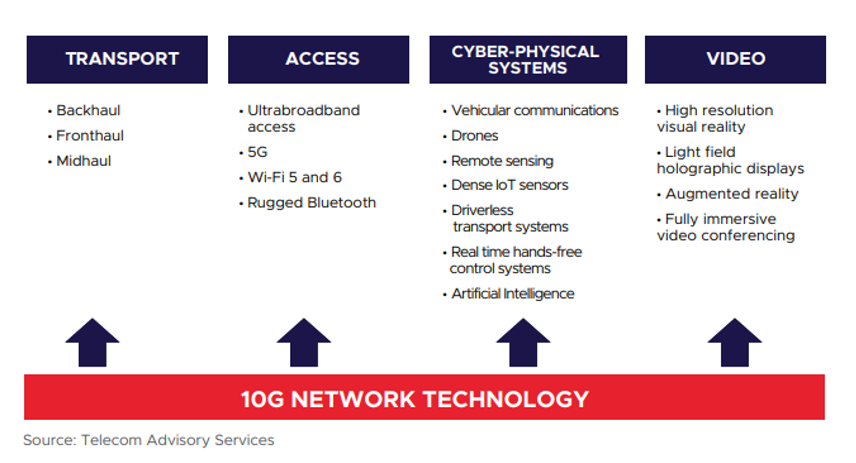“We are seeing the beginning of things. Web 2.0 is broadband. Web 3.0 is 10 gigabits a second” said Reed Hastings, CEO of Netflix. By definition, broadband is the transmission of bandwidth data over a high-speed internet connection, allowing you to enjoy everything that can be found online.
In a world where staying connected is more of a necessity than before, the demand for broadband that can provide unfaltering and seamless internet access is greater than ever. To address this, talks about 10G broadband has been hot as it ideally delivers internet speeds 10 times faster than today’s networks — providing a much better consumer experience. Not only that, but 10G is expected to provide faster symmetrical speeds, lower latencies, enhanced reliability, and better security in a scalable manner.
Similar to the 4G to 5G upgrade, 10G broadband will gradually be built on existing infrastructure. How does a passive optical network (PON) system — designed to deliver broadband Internet access — evolve and to be capable to supply a higher bandwidth? Let’s discuss.
Gigabit Internet
Gigabit availability has increased significantly, given the demand on catering to advanced technologies like virtual reality (VR), augmented reality (AR), and artificial intelligence (AI). To avoid any confusion, for 10G internet, the 'G' stands for gigabit, and it is the cable industry's vision for delivering a remarkable speed of 10 gigabits per second to homes globally.
Generally, a good standard internet broadband speed is around 11Mbps - 25Mbps. Though nowadays 100Mbps or higher is the sought-after speed of many. Taking this into consideration, 10G might seem a long way to go. But, as a matter of fact, the cable gigabit service availability rose from 4% to 80% within US households in just two years.
This shows that cable broadband providers continue to focus on improving the end-to-end experience for customers by steadily increasing capacity and performance within the broadband network. This well-established track record of increasing broadband availability is a great indicator of delivering the 10G promise
In the UK, the government has launched its new £5bn ‘Project Gigabit’ where more than one million hard-to-reach homes and businesses will have access to next-generation gigabit broadband. Furthermore, in the Middle East, operators boast some of the world’s highest fiber penetration levels. Following this, the implementation of 10G will require cable operators to drive fiber deeper into their networks.
How 10G-PON works
“Every day, broadband is connecting the unconnected. From education to health care to economic opportunity, more people around the world continue to benefit from living in a fully digitized world,” said Tae Yoo, senior vice president of corporate affairs at Cisco.
In today’s digital era, a passive optical network (PON) is unique as it can deliver high broadband connections using optical fiber for multiple end-users. Moreover, the PON architecture that adopts a Point-to-multipoint (P2MP) approach is becoming increasingly popular for its efficiency and cost-effectiveness over copper networks.
Prevalent PON technologies include broadband passive optical network (BPON), Ethernet passive optical network (EPON), and gigabit passive optical network (GPON). Out of these three, GPON is, to date, the most widely used mainstream optical access technology which is defined by ITU-T Recommendation G.984.x.
10G-GPON has evolved from the existing GPON technology. This evolution has been necessary to be done as services require higher bandwidths and the previous GPON technology cannot meet bandwidth requirements. It is worthy to note that 10G-GPON has two standards: XG-PON and XGS-PON.
The XG-PON has a bandwidth of 10G for downstream and 2.5G for upstream while XGS-PON has the bandwidth of 10G for downstream and 10G for upstream. Therefore, XGS-PON is a higher bandwidth and symmetric version of GPON. The same capabilities of 10G-GPON can co-exist on the same fiber with GPON as it utilizes a single fiber that runs through a passive optical splitter. This provides a broadband connection for up to 32 optical network terminals (ONTs).
The 10G-PON allows the delivery of high-speed data services and includes DOCSIS-style provisioning which makes configuring and managing fiber customer premises equipment easy. Omdia released a PON equipment market forecast report claiming that the future compound annual growth rate (CAGR) of 10G GPON will reach 62%.
Next-generation 10G-PON technologies (XGS-PON, 10G-EPON, and NG-PON2) offer the scale, flexibility, and reliability to enable a world that converges residential, enterprise, and 5G-enabled applications. In February 2021, Japan’s leading cable broadband provider Jupiter Telecommunications selected CommScope’s XE4202 10G-EPON Remote OLT fiber node module to deliver 10Gbps broadband within the Kansai region.
While mainstream 10G broadband access is still a great leap, the technologies that enable it are already in development. The cable industry, for one, has invested significant effort into laying the groundwork for 10G. With constant innovation, the 1G of today will certainly scale to 10G in the upcoming years.
10G: The next-generation bandwidth
The deployment of several types of DOCSIS technologies will improve the performance of our existing networks, reaching 10Gbps speeds. In detail, DOCSIS 3.1 gives the ability to transmit up to 50% more data, enabling improved quality of video conferencing, VR, live gaming, and connected devices. Aside from that, it also supports symmetrical upload and download speeds that shorten response time to 1-millisecond latency.
Amid the COVID-19 pandemic that brought to light the importance of digitalization, 10G is ideally suited to facilitate the immersive shift. The global use cases not only require 10G alone but also 5G for high-speed mobile connectivity and high-speed throughput Wi-Fi routers.
Wireless operators will use broadband for mobile backhaul, reducing the strain on the mobile network and improving overall wireless service. Thus, 10G broadband technology is going to enable the wireless 5G future.
Our digital future is expected to be better with 10G as it provides a myriad of new immersive digital experiences and other emerging technologies that will usher in the era of “smart homes,” “smart cities,” and even “smart industries.” Its impact will undeniably be felt in every sector, resulting in a billion-dollar economic output.










